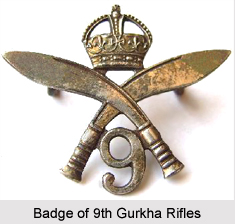 The 9th Regiment of Bengal Native Infantry was one of the prominent Gorkha units of the British Indian Army. The regiment was raised in the year 1817 under the administration of the British East India Company. It was a division of the Bengal Native Infantry, which was a part of the Bengal Army, before the Sepoy Mutiny of 1857. The armed military forces of Bengal Presidency were among of the 3 chief Presidency Armies in British India. The military regiment also served a part of the Bengal Command. The forces of the British Presidencies operated under the East India Company until the Great Revolt of 1857. The Government of India Act 1858, sanctioned after the occurrence of the rebellion, transferred the administration of the 3 Presidency Armies from the English East India Company to the British Empire in India. The unit Gorkha regiment was popularly known as the 9 Gorkha Rifles (9th Gurkha Rifles). After the Indian independence, the unit became a part of the Indian Army as part of the tripartite agreement.
The 9th Regiment of Bengal Native Infantry was one of the prominent Gorkha units of the British Indian Army. The regiment was raised in the year 1817 under the administration of the British East India Company. It was a division of the Bengal Native Infantry, which was a part of the Bengal Army, before the Sepoy Mutiny of 1857. The armed military forces of Bengal Presidency were among of the 3 chief Presidency Armies in British India. The military regiment also served a part of the Bengal Command. The forces of the British Presidencies operated under the East India Company until the Great Revolt of 1857. The Government of India Act 1858, sanctioned after the occurrence of the rebellion, transferred the administration of the 3 Presidency Armies from the English East India Company to the British Empire in India. The unit Gorkha regiment was popularly known as the 9 Gorkha Rifles (9th Gurkha Rifles). After the Indian independence, the unit became a part of the Indian Army as part of the tripartite agreement.
History of 9th Regiment of Bengal Native Infantry
The 9th Regiment of Bengal Native Infantry was raised as the Fatehgarh Levy at Infantry Levy at Fatehgarh in the year 1817. It was renamed as the 63rd Regiment in 1823 and became a part of the Bengal Native Infantry. After the Mutiny, the armed forces of the East India Company were reformed and it was titled as the 9th Bengal Native Infantry. One of the companies of the regiment consisted of only Gorkhas and people from other hill tribes.
The unit took part in conflict at Bharatpur state and also fought in the Battle of Sobraon during the First Anglo Sikh War. Eventually, the battalion included only Gorkhas of Khas origin. The 9th Regiment of Bengal Native Infantry was designated as the 9th Gorkha Rifles during the Kitchener reforms in the year 1903. The troops of the Gorkha regiment actively served during the First World War and were stationed in Europe. It later participated in the military actions in the North West Frontier. During the Second World War, the 9th Bengal Native Infantry provided service in North Africa and Italy.
Development of 9th Regiment of Bengal Native Infantry
After the nation achieved freedom from the domination of the British administration on 15th August 1947, the Union of India and the Dominion of Pakistan was formed through the Partition of India. Accordingly, the regiments of British Indian Army were shared among the forces of India and Pakistan. The 9 Gorkha Rifles was assigned to the modern Indian Army as part of the Tripartite Agreement between India, Britain and Nepal.
Designations of 9th Regiment of Bengal Native Infantry
The different titles held by the 9th Regiment of Bengal Native Infantry is listed below-
* Fatagarh Levy (1817- 1819)
* Mianpuri Levy (1819- 1824)
* 63rd Regiment of Bengal Native Infantry (1824- 1861)
* 9th Regiment of Bengal Native Infantry (1861- 1885)
* 9th Regiment of Bengal Infantry (1885- 1894)
* 9th (Gurkha Rifle) Bengal Infantry (1894- 1901)
* 9th Gurkha Rifles (1903- 1947)
* 9 Gorkha Rifles (1950)
Battle Honours of 9th Regiment of Bengal Native Infantry
The 9 Gorkha Rifles was awarded with a number of battle honours for their valiant and valuable services. These are mentioned below-
* Bharatpur
* Sabraon
* Afghanistan (1879- 1880)
* Punjab Frontier
* La Bassee
* Festubert
* Armentiers
* Givenchy
* Neuve Chapelle
* Aubers
* Loos
* France and Flanders
* Tigris
* Kut-al-Amara
* Mesopotamia
* Djebel-el-Maida
* Djebel Garci
* Ragoubet Scuissi
* Chindit
* Tavoleto
* Hangman`s Hill
* San Marino
* Baghdad
* Cassino



















